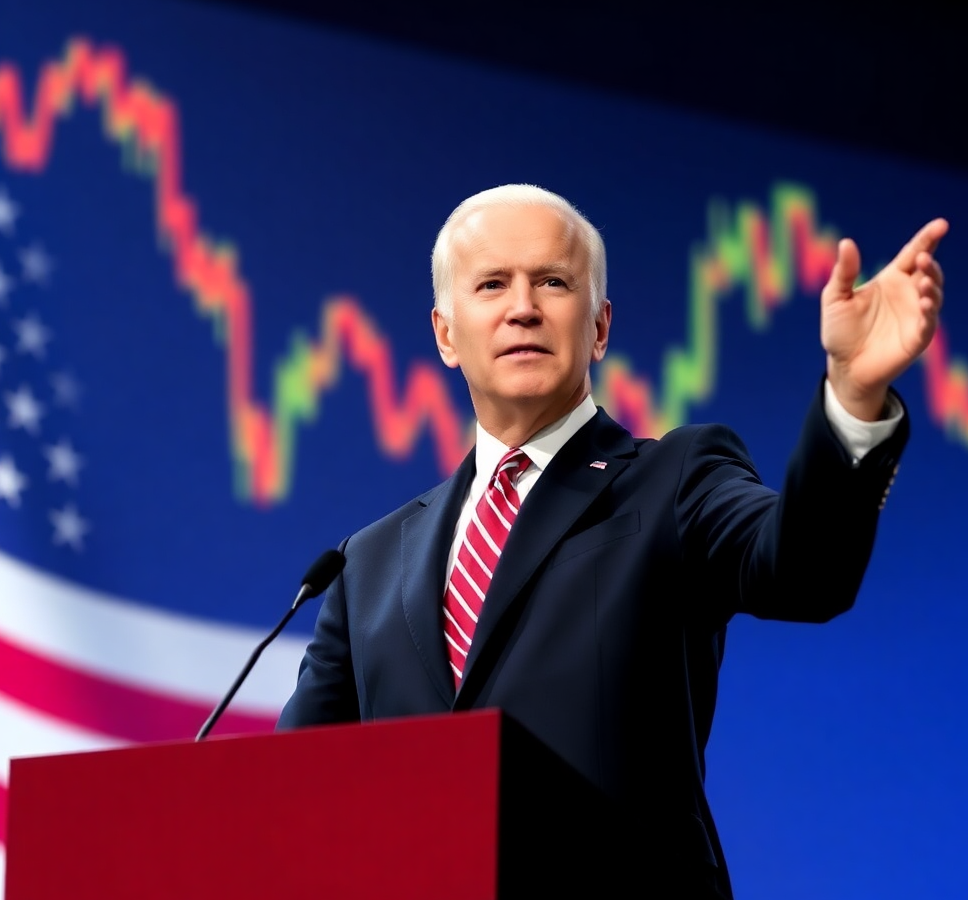
The U.S. stock market is often viewed as a barometer for the overall health of the economy, and its performance during Joe Biden’s presidency provides valuable insights into the challenges and successes of his administration. As Biden completes his first term, it is important to examine how the market performed under his leadership, what factors influenced its movements, and what this means for future economic policy.
Biden’s presidency began in the shadow of the COVID-19 pandemic, and the economic conditions he inherited were complex and uncertain. The pandemic had triggered a sharp recession in 2020, but the stock market had rebounded quickly due to federal stimulus packages, low-interest rates, and an aggressive monetary policy from the Federal Reserve. Biden’s administration focused on rebuilding the economy, managing the pandemic, and stimulating growth through fiscal policies like the American Rescue Plan. However, the stock market experienced notable ups and downs due to inflation, interest rate hikes, and global uncertainties.
In this article, we take an in-depth look at the performance of the U.S. stock market under Joe Biden, analyzing major stock indices like the S&P 500, Nasdaq, and Dow Jones Industrial Average (DJIA), examining the various factors that influenced market behavior, and assessing how Biden’s policies shaped economic outcomes.
Introduction: The Economic Landscape at the Start of Biden’s Presidency
When Joe Biden assumed the presidency on January 20, 2021, the U.S. economy was still grappling with the lingering effects of the COVID-19 pandemic. The pandemic-induced recession had left millions unemployed and strained businesses across industries. Despite the recession, the stock market had staged a remarkable recovery from its 2020 lows. This recovery was largely attributed to government stimulus measures, the rapid development of COVID-19 vaccines, and aggressive monetary policy, all of which were aimed at revitalizing the economy.
However, the road ahead was far from clear. Biden’s administration inherited a challenging economic environment, with unemployment levels remaining high, ongoing disruptions in global supply chains, and growing inflation concerns. The stock market had been buoyed by optimism regarding vaccine rollouts and fiscal stimulus, but as the economy began reopening, new uncertainties started to emerge.
One of Biden’s primary goals was to secure a comprehensive economic recovery plan. A key component of his approach was the American Rescue Plan, a $1.9 trillion stimulus package passed in March 2021. The plan included direct payments to households, extended unemployment benefits, and funding for public health initiatives. It was expected that this relief would boost consumer spending, leading to higher demand for goods and services and, by extension, a continued market rally.
The Post-Pandemic Recovery Boom
The year 2021 marked a period of strong economic recovery under Biden’s leadership. With widespread vaccine distribution and an easing of COVID-19 restrictions, businesses were able to reopen, and the labor market began to recover. The stock market responded positively to this resurgence, posting strong gains across major indices.
The S&P 500, for instance, achieved a 26.9% return in 2021, reflecting its third-best performance in over two decades. This robust growth was driven in part by sectors like technology, healthcare, and consumer discretionary, which benefited from continued shifts in consumer behavior and the acceleration of digital transformation. The Nasdaq Composite, which is heavily weighted towards technology stocks, also posted a solid 21.4% gain, despite some volatility in specific sectors.
Biden’s economic recovery efforts focused on job creation, infrastructure investment, and consumer support. The passing of the American Rescue Plan played a significant role in this recovery, as direct payments to households, expanded unemployment benefits, and increased funding for COVID-19 testing and vaccination programs helped inject capital into the economy. As businesses reopened, there was an uptick in consumer spending, which, in turn, buoyed stock prices across multiple sectors.
While most sectors saw growth, the technology sector continued to be a primary driver of stock market performance. Companies like Apple, Microsoft, Amazon, and Tesla achieved record valuations, benefiting from ongoing digital transformation trends accelerated by the pandemic. Remote work, cloud computing, e-commerce, and artificial intelligence were key growth areas that lifted tech stocks to new heights.
In addition to technological innovations, the pandemic also underscored the critical importance of healthcare and life sciences. Biotech companies saw strong stock performances as they led the way in developing COVID-19 vaccines, therapeutics, and testing methods. As the global demand for these innovations surged, healthcare stocks played a crucial role in the overall market performance under Biden.
Challenges of 2022: Inflation and Rising Interest Rates
While 2021 was marked by an economic boom, the subsequent year proved more challenging as inflationary pressures became a dominant concern. By the middle of 2022, inflation had reached its highest levels in over 40 years, with the Consumer Price Index (CPI) peaking at 9.1% in June 2022. This surge in inflation was attributed to several factors, including rising energy prices, supply chain disruptions, and increased consumer demand as the economy reopened.
In response to these rising inflationary concerns, the Federal Reserve began aggressively raising interest rates. The Fed’s decision to hike interest rates represented a shift in monetary policy, aiming to curb inflation by making borrowing more expensive and slowing down demand. The rate hikes, however, had significant implications for the stock market.
Growth stocks, particularly in the technology sector, were among the hardest hit. Higher interest rates reduce the present value of future earnings, which can lower stock valuations. Companies that had seen rapid growth in the previous years saw their stock prices decline as investors reevaluated their future prospects. The Nasdaq Composite, which is heavily weighted in technology, posted its worst annual performance since the bursting of the dot-com bubble in 2000, falling by 33.1% in 2022.
Similarly, the S&P 500 and Dow Jones Industrial Average experienced declines, posting annual losses of 19.4% and 8.8%, respectively. These declines reflected the broader market’s reaction to higher interest rates, which dampened investor enthusiasm for growth stocks and led to a shift toward defensive investments.
The energy sector was one of the few areas to show strong performance during this period. The geopolitical tensions surrounding the Russia-Ukraine conflict, which escalated in early 2022, led to a disruption in global oil and gas supply chains. This contributed to rising energy prices, which helped boost the profitability of energy companies. Stocks of companies like ExxonMobil and Chevron saw significant gains during this period.
Despite these challenges, there were positive aspects to the U.S. economy. The unemployment rate remained low, and labor force participation began to recover. Biden’s administration continued to emphasize infrastructure spending and job creation, which helped mitigate some of the negative effects of inflation and rising interest rates.
2023: Technology-Driven Recovery and Global Uncertainty
As 2023 progressed, the U.S. stock market began to show signs of recovery, especially in the technology sector. Companies that had suffered the most during the interest rate hikes of 2022 began to bounce back as inflation showed signs of moderating and the Federal Reserve signaled a potential pause in its rate-hiking cycle. This environment encouraged investors to re-enter growth stocks, which had become more attractively valued after their significant declines.
The Nasdaq Composite posted a strong rebound, climbing by 20% in 2023, as investors regained confidence in the long-term growth prospects of technology companies. The S&P 500 also recorded modest gains, up 11%, while the DJIA showed more moderate growth. However, challenges remained. Geopolitical tensions, including the ongoing Russia-Ukraine conflict, posed risks to global stability. Additionally, supply chain disruptions continued to impact certain sectors, particularly in manufacturing and consumer goods.
In response to these challenges, Biden’s administration pushed forward with its economic agenda, focusing on expanding infrastructure investments and clean energy projects. The Biden administration’s $2.3 trillion infrastructure bill, aimed at modernizing the country’s roads, bridges, and digital infrastructure, began to pay dividends in the form of job creation and economic growth. Green energy initiatives, such as investments in solar power, electric vehicles, and energy efficiency, also garnered significant attention from investors.
Biden’s Stock Market Legacy: Looking Ahead
As Biden’s first term nears its end, the stock market has experienced significant fluctuations, driven by a combination of fiscal and monetary policy decisions, global uncertainties, and technological advancements. While the market faced challenges, including inflation, interest rate hikes, and geopolitical tensions, it also benefited from a robust economic recovery in 2021 and a resurgence in technology stocks during the latter part of his term.
Looking ahead, Biden’s stock market legacy will be defined by the long-term effects of his economic policies. The recovery from the pandemic and the structural shifts in industries like technology and clean energy will continue to shape market dynamics. While challenges like inflation and interest rate hikes may persist, Biden’s focus on infrastructure investment, job creation, and green energy could create new opportunities for growth.
Feel free to check out our other website at : https://synergypublish.com


